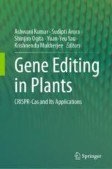Search
Search Results
-
Integument
The skin of birds keeps out pathogens and other potentially harmful substances, retains vital fluids and gases, serves as a sensory organ, and...
-
Silicon fertilisation affects morphological and immune defences of an insect pest and enhances plant compensatory growth
Herbivorous insects have evolved various anti-predator defences, including morphological, behavioural, and immune defences, which can make biocontrol...

-
CRISPR-Based Genetic Control Strategies for Insect Pests to Mitigate Classical Insecticidal Approaches
Nutraceutical properties of food have always been an important interface of concern as food directs both physical and mental health and forms the...
-
Diversity of transgenes in sustainable management of insect pests
Insecticidal transgenes, when incorporated and expressed in plants, confer resistance against insects by producing several products having...

-
Insect phenoloxidase and its diverse roles: melanogenesis and beyond
Insect life on earth is greatly diversified despite being exposed to several infectious agents due to their diverse habitats and ecological niche....

-
AA15 lytic polysaccharide monooxygenase is required for efficient chitinous cuticle turnover during insect molting
Microbial lytic polysaccharide monooxygenases (LPMOs) catalyze the oxidative cleavage of crystalline polysaccharides including chitin and cellulose....

-
Polymorphisms in Insect Predators
The behaviour, life history, physiology, and morphology of natural enemies’ victims are all affected in different ways. Scientists and naturalists...
-
A CTL − Lys immune function maintains insect metamorphosis by preventing gut bacterial dysbiosis and limiting opportunistic infections
BackgroundGut bacteria are beneficial to the host, many of which must be passed on to host offspring. During metamorphosis, the midgut of...

-
Beauveria bassiana transcriptomics reveal virulence-associated shifts during insect lipid assimilation
AbstractInsect cuticular lipids, especially epicuticular hydrocarbons (CHC), have a significant role in insect ecology and interactions with other...

-
Cuticular protein genes are involved with insecticide resistance mechanism in red flour beetles, Tribolium castaneum (Coleoptera: Tenebrionidae)
The insect integument, which consists mainly of chitin microfibrils and cuticular proteins, is an extracellular matrix that covers the entire...

-
Offense and Defence Mechanism of Insect Predators
In contrast to predatory aggression, offence and defensive behaviours are two types of aggression that are displayed by one member of a species...
-
Molecular mechanisms, genetic map**, and genome editing for insect pest resistance in field crops
Key messageImproving crop resistance against insect pests is crucial for ensuring future food security. Integrating genomics with modern breeding...

-
Improvement of Resistance in Plants Against Insect-Pests Using Genome Editing Tools
During growth period plants are subjected to both biotic and abiotic stresses. Like other biotic stresses, insect-pests are the most serious...
-
Entomopathogenic microorganisms: their role in insect pest management
BackgroundEntomopathogens are pathogenic to insect pests. Several types of naturally occurring, viz. fungus, bacteria, viruses, and nematodes, infect...
-
Glucosinolate-Myrosinase System and Its Role in Specialist and Generalist Insect Herbivores
One of the best-studied plant chemical defenses is the glucosinolate-myrosinase system found in plants of the family Brassicaceae. There is...
-
Morphological, Biological, and Molecular Characterization of Type I Granuloviruses of Spodoptera frugiperda
Granuloviruses (GVs) Betabaculovirus associated with the fall armyworm (FAW), Spodoptera frugiperda (J.E. Smith) (Lepidoptera: Noctuidae), especially...

-
Comparative roles of three adhesin genes (adh1–3) in insect-pathogenic lifecycle of Beauveria bassiana
AbstractAdherence of conidia to insect integument is crucial for initiation of fungal infection through cuticular penetration and was previously...

-
Perspectives of Beauveria bassiana, an entomopathogenic fungus for the control of insect-pests in tea [Camellia sinensis (L.) O. Kuntze]: opportunities and challenges
Injudicious and indiscriminate use of toxic chemicals in tea deteriorates the plant, soil, and environment and escalates maximum residue limits...

-
Cuticular competing endogenous RNAs regulate insecticide penetration and resistance in a major agricultural pest
BackgroundThe continuously develo** pesticide resistance is a great threat to agriculture and human health. Understanding the mechanisms of...

-
Oral-based nanoparticle-wrapped dsRNA delivery system: a promising approach for controlling an urban pest, Blattella germanica
Chitin synthase is an indispensable enzyme that is involved in the synthesis of chitin, a key component of the insect cuticle during insect...

